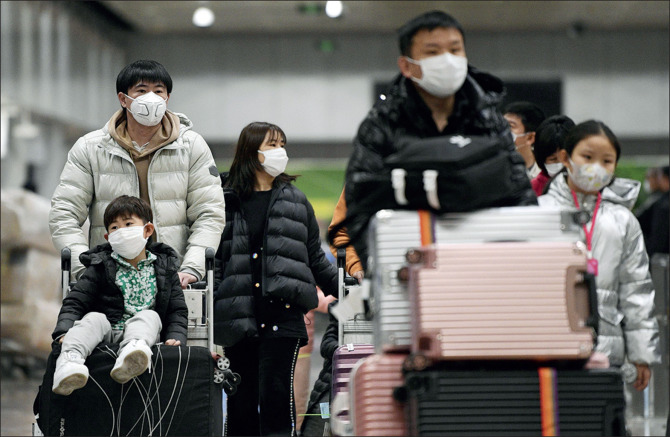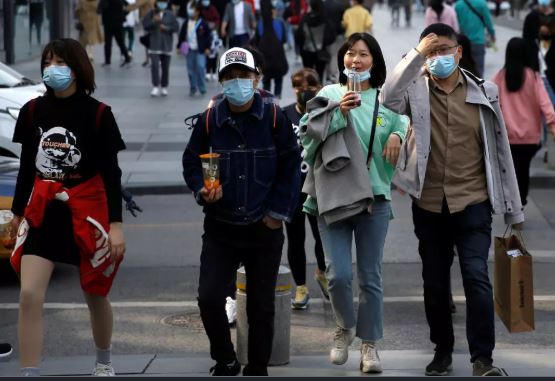 English
English

China has revised the death toll in Wuhan by adding 1290 more fatalities to make up for certain missed cases due to late/faulty reporting, omissions or misreporting by an overburdened health infrastructure during early phases of outbreak in the capital city of central Hubei province.

Beijing (China): There may be various allegations by western countries related to data reporting by china along with lack of clarity on the origin of the virus. Even though, a second round of infections including asymptomatic cases may be seen in Wuhan after the lockdown removal on 15th April. But the fact remains that China has seen the peak of COVID-19 and is now focussing more on preventing imported cases in its territory. It has also allowed people’s movement in an attempt to show that Wuhan is back on its feet after more than 2 and half month’s lockdown. But it is easier said than done.
A recall
Since the official reporting of first case in Wuhan on 31 December 2019, origin of the virus remained untraceable though the epicentre of the outbreak was identified as a seafood market. The outbreak could not have happened at a worst time when Chinese New Year celebrations were around the corner and mass movement of millions of Chinese people took place from cities to the hinterland and to many parts of the world. Lack of judgement about its seriousness was also visible when in Wuhan on 18th January, a mass feast was organised as part of Spring Festival celebrations in which thousands of people participated, despite the fact that Wuhan had reported many cases till then. This had blown the infections out of proportion and on the eve of Wuhan lockdown, around 5 million people moved out of central Chinese city, to take the matters out of hand for Chinese authorities. Wuhan authorities and CCP leaders also later accepted that Wuhan lockdown was a late decision which and exacerbated the situation. Before other countries could realise this rising tide of pandemic, in the absence of any such advice from WHO, virus has spread its tentacles to close to two dozen countries in January and then started a flurry of visa cancellations and many other restrictions on flights etc by countries.
China on War footing
China, once acknowledged, put all its might and resources in tackling the burgeoning cases and mounting death tolls. All the new year celebrations were cancelled, and school, colleges, universities and offices closed. Masks were made mandatory in public places from the beginning and a massive awareness campaign was launched nationwide. Rigorous thermal screenings were put in place across the country. Wuhan health infra had almost crumbled and there was severe shortage of PPEs for healthcare workers and mask shortage had become a country-wide problem. Chinese govt tried to import many of these in addition to ramping up the production in the country. Many countries including India supplied medical aid too to China as a token of their support in humanity’s fight against novel coronavirus. All the new year leaves of doctors were cancelled, and they were mobilised from all over the country to Wuhan including military doctors. China built two big makeshift dedicated COVID-19 hospitals and converted many existing infra into COVID hospitals. Many doctors and healthcare workers had to lay their lives in this battle. Meanwhile, many countries including India evacuated their citizens from Wuhan.

Ripples
Coronavirus Outbreak caused many social, political and economic issues. Chinese netizens took to twitter like Weibo to vent their frustration and even Wuhan authorities later accepted mishandling of the situation. Lockdown unleashed unimaginable miseries on the residents of Wuhan city in the initial days before the local govt took over the charge of supplying daily essentials to doorsteps, later allowing one designated person from a family to go out once in two days. Even then, there were almost no reports of any public law and order situation as people fell in line with govt orders. RWAs and community housing societies were actively involved in keeping people engaged and a tight vigil on the lockdown norms. Many WeChat groups were created by local authorities to sort out difficulties faced by the people. Many cities in nearby provinces of Hubei also witnessed a surge in cases and resulting disruptions. Major focus of the govt was to keep the ration and vegetable supplies to worst hit cities in Hubei.
Despite state media showing reports national fight against virus full of hope and courage, news of coronavirus infections mingled with the deluge of conflicting information tumbled out daily. Panic buying spree continued for even a traditional Chinese medicine syrup on the heels of the frenzy over face masks. After a report cited its effectiveness, snaking queues were seen outside pharmacies in the ground zero of Wuhan and many other cities which also tripled its online prices. Such indulgent buying had also sprawled to masks, hand sanitizers, thermometers, and staple food. Panic has also fueled discrimination, as there were numerous reports of such cases against residents from Hubei Province and discrimination abroad against Chinese people. Some reputed foreign news publications abroad have been criticized over discriminative headlines against china and were later retaliated by China.
Beijing, Shanghai NOT affected?
Big metropolis like Beijing, Shanghai, Guangzhou etc. were less affected comparatively (as per official data) by the very fact that they did not have much native population. Most of the residents in the city had moved out to their hometowns for new year and cities wore a deserted look even a week before the actual new year. This is a common trend for all big cities in china during every new year. Cases in such cities were mainly those who came back from either Wuhan or a close contact of a patient. Bustling streets and markets of Beijing, the national capital, were deserted with public transport plying almost empty and people maintaining social distancing. Community housing system with system of tokens for entry-exit helped a lot in checking the unnecessary movement of people. Govt had consciously put extra efforts to keep Beijing, shanghai and other major hubs running with least hiccups with essential supplies intact. At present, Beijing citizenry is tiptoeing back to their normal lives but not without rigorous checking at public places which include confirming the presence in Beijing in last 14 days through a mobile app. Many public places like restaurants have reduced the maximum strength at a time to maintain social distancing.
Future still Hazy
Chinese Govt after the extended new year holidays in first week of February, Chinese government has worked to bring sizeable and targeted economic aid to entrepreneurs, individuals, and businesses with prime focus on companies making necessary equipment for the world to deal with the pandemic. China’s attempts to enhance liquidity in markets, support debt and equity financing, and reduce fees and taxes have helped keep small and medium companies in business and to keep workers employed, and medical supplies and other necessities in production. Government slashed value-added-tax rates for companies in the Hubei Province, exempted small businesses from paying into China’s social-security system for the time being, and suspended local tolls and tariffs. Even then informal sector was paralysed with almost nil income in hand. Though People’s Bank of China announced a multi-billion dollars’ economic package for industries in February itself, the growth forecast for the economy was hit.
China being a major link in global supply chain, was not able to supply the raw material due to lack in its production in initial phases. China’s economic response helped it in regaining its position to some extent but now, world economy shattered by COVID-19 is not producing enough demand other than medical supplies and thus affecting manufacturers in China. China is an export-heavy economy, is acutely vulnerable to how well the rest of the world can ward off the pandemic. As a matter of fact, China's GDP has shrunk by 6.8% in Q1 2020, the first contraction since records began in 1992 as the coronavirus outbreak paralysed production and spending, raising pressure on authorities to do more to stop mounting job losses.

In many ways, despite criticism of varying nature, China’s actions guided the global response to the crisis, as other governments used similar policy tools to confront the shock to their national conscience and economies. India in particular being world’s second largest population has to focus on a countrywide response as against China which hugely targeted its response to Wuhan. Also, China did not face any situation like crowd gathering at Anand Vihar in Delhi or Bandra Terminus in Mumbai which was swiftly handled by Indian govt agencies. One notable difference is that China didn’t make the same direct cash infusions to workers as India did in the form of Pradhan Mantri Gareeb Kalyan Yojna through DBT. As per some experts, Chinese government can launch bigger amount of subsidies in the near future, in the form of coupons, to get people to shop rather than add to their savings.
As Globalisation has seen the fault lines coming to the fore, India would do well in implementing the calibrated exit plan for industries and for its unorganised after 20th April so that migrant labourers and other daily wagers do not face much hardships. MHA guidelines in this regard are timely. Till now, India has put up a great national effort to fight this pandemic, however, it may be argued whether India could have taken more stringent and effective steps during its lead time for preparation before the reporting of first case in the country. Nonetheless, every country can be given benefit of doubt in not becoming an alarmist during the course of alerting its citizens.
Even as China has revised the death tolls in Wuhan, getting real data about infections and casualties from across the globe is very important to gauge the real impact of this pandemic and to prepare our healthcare infra about any future onslaughts as this is not the last outbreak. One thing is sure that health authorities worldwide were little prepared to cater to this pandemic.
(The writer, Anshuman Mishra, is an IIS officer of 2011 batch. Views are personal.)
No related posts found.